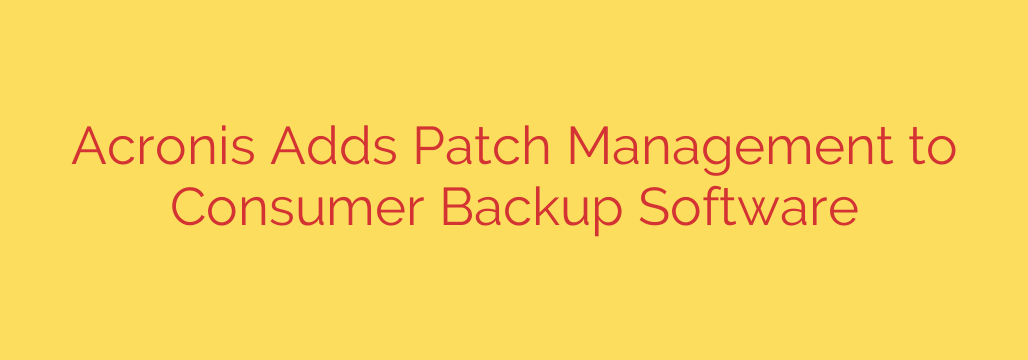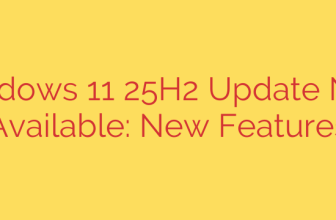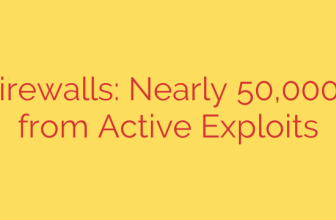
The Unsung Hero of Cybersecurity: Why Your Home PC Needs Patch Management
When you think about protecting your home computer, your mind probably jumps to antivirus software and a strong password. While those are essential, one of the most critical and frequently overlooked security layers is patch management. For years, this was a term reserved for corporate IT departments, but the game has changed. The same vulnerabilities that plague large companies exist on your home PC, and managing them is now more crucial than ever.
So, what exactly is this vital security process, and why does it suddenly matter for you?
What is Patch Management?
At its core, patch management is the process of identifying, testing, and applying software updates, or “patches,” to your computer. This isn’t just about your operating system, like Windows or macOS. It encompasses all the third-party applications you use every day: your web browser (Chrome, Firefox), communication tools (Zoom, Slack), document editors (Adobe Acrobat), and media players.
Think of it like maintaining your home. A software vulnerability is like a broken lock on a window. You might not notice it, but a thief who knows what to look for can exploit it easily. A software patch is the new, stronger lock that fixes the vulnerability, securing that entry point before anyone can break in.
The Real Danger: Why Outdated Software is a Goldmine for Hackers
Hackers love unpatched software. When a security flaw is discovered in a popular application, the software vendor rushes to release a patch to fix it. At the same time, cybercriminals reverse-engineer that patch to understand the exact vulnerability it solves. They then create automated tools that scan the internet for any computer that hasn’t installed the update yet.
This creates a critical race against time. If you’re slow to update, you leave a wide-open door for attackers. These exploits can lead to:
- Ransomware Attacks: This is the most devastating outcome. Attackers exploit a vulnerability to encrypt all your personal files—photos, documents, financial records—and demand a hefty ransom for their release.
- Data Theft: Cybercriminals can steal sensitive personal information, including bank logins, passwords, and private messages, by exploiting weaknesses in your software.
- System Takeover: An unpatched flaw could give an attacker complete control over your computer, allowing them to use it to launch other attacks or install persistent spyware.
The hard truth is that your antivirus program may not be able to stop an attack that leverages a known, unpatched vulnerability. Antivirus software is designed to detect malicious files and behaviors, but if an exploit targets a fundamental flaw in a trusted application, it can often bypass traditional defenses.
The Evolution of Home Cybersecurity: From Backup to All-in-One Protection
For a long time, home users had to juggle separate tools: one for backups, one for antivirus scans, and another for malware removal. Manually keeping every single application updated was a tedious, often forgotten, chore.
Recognizing this gap, the cybersecurity industry is evolving. Leading security suites are now integrating patch management directly into their consumer-grade products. For example, solutions like Acronis Cyber Protect Home Office are moving beyond simple data backup to offer a comprehensive “cyber protection” platform.
These integrated solutions now provide a single, easy-to-use dashboard that not only backs up your files and scans for viruses but also:
- Scans for outdated software across your entire system.
- Assesses the severity of any discovered vulnerabilities.
- Allows you to approve and install all necessary patches with a single click.
This centralized approach makes robust security accessible to everyone, not just IT professionals.
Actionable Tips for Securing Your Digital Life
Protecting your computer from these threats requires a proactive, layered defense. Here is what you can do right now to improve your security posture:
- Enable Automatic Updates: For your operating system (Windows/macOS) and your primary web browser, ensure automatic updates are turned on. This is your first and most important line of defense.
- Don’t Ignore Update Prompts: When an application like Adobe Reader or Zoom prompts you to install an update, do it as soon as possible. Don’t click “remind me later” indefinitely.
- Audit Your Applications: Periodically uninstall software you no longer use. Every program installed on your computer is a potential attack surface; reducing that number reduces your risk.
- Consider an Integrated Security Solution: To simplify the process and ensure nothing falls through the cracks, look into a modern cybersecurity suite that explicitly includes vulnerability assessment and patch management alongside its backup and anti-malware features.
- Maintain Regular Backups: Even with perfect patching, a defense is never foolproof. A reliable, recent backup of your important data is your ultimate safety net against ransomware or hardware failure.
Ultimately, robust cybersecurity is no longer just about reacting to threats. It’s about proactively closing security gaps before they can be exploited. By making patch management a core part of your security routine, you are taking one of the most powerful steps you can to protect your data and your digital life.
Source: https://www.helpnetsecurity.com/2025/09/30/acronis-true-image-2026/








